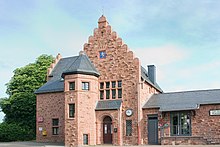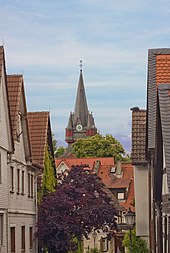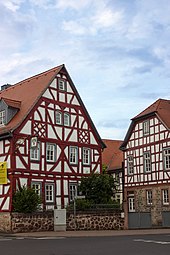Altenstadt (Hesse)
| coat of arms | Germany map | |
|---|---|---|

|
Coordinates: 50 ° 17 ' N , 8 ° 57' E |
|
| Basic data | ||
| State : | Hesse | |
| Administrative region : | Darmstadt | |
| County : | Wetteraukreis | |
| Height : | 127 m above sea level NHN | |
| Area : | 30.09 km 2 | |
| Residents: | 12,226 (Dec. 31, 2019) | |
| Population density : | 406 inhabitants per km 2 | |
| Postal code : | 63674 | |
| Area code : | 06047 | |
| License plate : | FB, BÜD | |
| Community key : | 06 4 40 001 | |
| Community structure: | 8 districts | |
| Address of the municipal administration: |
Frankfurter Str. 11 63674 Altenstadt |
|
| Website : | ||
| Mayor : | Norbert Syguda ( SPD ) | |
| Location of the municipality of Altenstadt in the Wetterau district | ||
Altenstadt is a German municipality in the Wetterau district in Hesse . The Nidder flows through the municipality , into which the Seemenbach , which comes from the Büdinger area, flows near Lindheim .
geography
Altenstadt is naturally located in the Heldenbergener Wetterau .
Neighboring communities
Altenstadt borders the city of Florstadt and Glauburg in the north, the city of Büdingen in the east, Limeshain in the southeast (all four in the Wetteraukreis), in the southwest on the city of Nidderau ( Main-Kinzig-Kreis ), and in the west the city of Niddatal (Wetteraukreis).
Community structure
Since the regional reform in Hesse, the districts of Altenstadt, Heegheim , Höchst an der Nidder , Lindheim , Enzheim , Oberau , Rodenbach and Waldsiedlung have belonged to the municipality . In addition, the Engelthal and Oppelshausen monastery , which is located a little outside the community of Altenstadt , consists of a few houses and a large golf course.
history
The Roman military camp
Since the first half of the 2nd century Altenstadt was garrison location of an unknown number ( see main article: Kastell Altenstadt ). At first he was stationed in a fort about one hectare in size . It was rectangular, fenced with wood and earth and surrounded by a moat. A gate and a corner tower are known. There are traces of various buildings in the interior. A new fort will then be built around 135 AD. It was probably more than 1 hectare in size and was fenced with sod. The northern half of the fort was offset slightly to the west. The complex had four gates, corner towers and was surrounded by a moat. A cellar storage building and remnants of the Principia, the commandant's house and a crew barracks are known of the interior structures.
Around the year 150 a 1.5 hectare (132 m × 114 m) stone fort with a rectangular floor plan with four gates, corner towers and numerous intermediate towers was built. Two trenches surrounded the fort. From the interior development one knows a water basin and remains of the principia , the presumed commandant's house, of the team barracks and other buildings. Before the number was stationed there were two small forts in the same place. They had a fence made of wood and earth and a ditch. The camp village stretched on all sides.
The Roman military installations in Altenstadt apparently had the task of blocking a probably pre-Roman path that led along the Nidder into the Vogelsberg and further to Fulda , as well as monitoring the Glauberg, only 5 km away , which was the seat of a Celtic prince in pre-Roman times and on which the Germans settled after the retreat of the Celts . The Romans, however, did not tolerate Celts or Teutons in any hilltop settlements in or on the edge of their domain. Today the fort area is almost completely built over. The history of the fortification is rather complicated, as it developed over the years from a small hill to a numerus fort (numerus = unit of about 150 men). The fort was destroyed twice: in the second half of the 2nd century and during the great Alemanni invasion around 233 AD. An inscription stone from 242 AD, which was recovered from a well in 1603, suggests that the fort was was occupied until the end of the Limes in 260 AD.
middle Ages
The oldest surviving mention of Altenstadt comes from the Lorsch Codex and from June 767. Medieval spellings were: Aldenstat , Altunstaten and Aldunstater marca . Altenstadt is the municipality of Upper Hesse with the earliest surviving mention.
In the Holy Roman Empire it belonged to the Kaichen Freigericht , which came under the rule of the Burggrafschaft Friedberg in the 15th century . With this it fell to Hessen-Darmstadt in 1806 .
Modern times
In Altenstadt, the particular law of the Kaichen Free Court, the Friedberger Police Regulations, applied . In 1679 it was renewed and printed. This is the first time that it can be put into writing. She mainly dealt with administrative , police and regulatory law . In this respect, the Solms land law remained the main source of law for the broad area of civil law . The Common Law was, moreover, if all these regulations did not contain provisions for a fact. This legal situation remained in force in the 19th century after Altenstadt was transferred to the Grand Duchy of Hesse . It was not until the Civil Code of January 1, 1900, which was uniformly valid throughout the German Reich , that this old particular law was suspended.
In the course of the regional reform in Hesse on October 1, 1971, the previously independent communities Höchst ad Nidder and Oberau were incorporated . On December 31, 1971, Heegheim and Lindheim were added. Rodenbach followed on August 1, 1972 by virtue of state law. Also on August 1, 1972, the district of Büdingen was dissolved and Altenstadt was assigned to the new Wetterau district .
politics
Community representation
The local elections on March 6, 2016 produced the following results, compared to previous local elections:
In September 2019, the election of Stefan Jagsch (NPD) as mayor of Altenstadt-Waldsiedlung caused a sensation by votes from the SPD, CDU and FDP. This was preceded by the fact that the previous mayor Klaus Dietrich (FDP) resigned out of annoyance at the lack of support from the local council and the local council of Altenstadt and no other candidate could be found.
| Parties and constituencies | % 2016 |
Seats 2016 |
% 2011 |
Seats 2011 |
% 2006 |
Seats 2006 |
% 2001 |
Seats 2001 |
||
|---|---|---|---|---|---|---|---|---|---|---|
| SPD | Social Democratic Party of Germany | 27.3 | 10 | 33.8 | 13 | 40.7 | 15th | 40.8 | 15th | |
| CDU | Christian Democratic Union of Germany | 25.5 | 9 | 32.8 | 12 | 35.9 | 13 | 37.9 | 14th | |
| FWG | Free voter community Altenstadt | 16.3 | 6th | 10.2 | 4th | 11.3 | 4th | 15.7 | 6th | |
| GREEN | Alliance 90 / The Greens | 14.0 | 5 | 17.4 | 6th | 7.1 | 3 | 5.6 | 2 | |
| NPD | National Democratic Party of Germany | 10.0 | 4th | 1.2 | 0 | 0.8 | 0 | - | - | |
| FDP | Free Democratic Party | 7.0 | 3 | 4.6 | 2 | 4.1 | 2 | - | - | |
| total | 100 | 37 | 100 | 37 | 100 | 37 | 100 | 37 | ||
| voter turnout | 49.7% | 41.8% | 51.8% | 47.6% | ||||||
mayor
The past mayoral elections produced the following results:
| year | Candidates | Political party | Result in% |
|---|---|---|---|
| 1994 | Gerhard Lipp | SPD | 58.2 |
| Werner Zientz | CDU | 15.7 | |
| Werner Neumann | Green | 9.3 | |
| Albert Dieter Hoff | 6.7 | ||
| Renate Künstler-Hardtmann | 0.5 | ||
| Udo Ehrenhardt | 9.6 | ||
| Turnout: 55.5% | |||
| 2000 | Norbert Syguda | SPD | 59.5 |
| Maria Baumberger | CDU | 40.5 | |
| Turnout: 48.7% | |||
| 2006 | Norbert Syguda | SPD | 64.3 |
| Hartmut Kinzer | CDU | 32.1 | |
| Dirk Waldschmidt | NPD | 3.6 | |
| Turnout: 52.0% | |||
| 2012 | Norbert Syguda | SPD | 74.0 |
| Sabine Lipp | CDU | 23.4 | |
| Daniel Knebel | NPD | 2.6 | |
| Turnout: 47.85% | |||
In the last election on April 1, 2012, the incumbent mayor Norbert Syguda (SPD) won with 74.0% against Sabine Lipp (CDU), who achieved 23.4%, and against Daniel Knebel (NPD), who won 2.6% reached. It is Norbert Syguda's third term in office. The turnout was 47.85%.
The first mayor after the war was Fritz Kreß (1896–1960), who was mayor from 1945 to 1960.
coat of arms
| Blazon : "In silver a red-armored black eagle, the chest covered with a gold A." | |
| Justification of the coat of arms: The Altstaetter ambt seal of the 18th century shows the one-headed imperial eagle, which appears in connection with the letter A on several boundary stones of the 18th century and (with a heart sign) also adorns the sign of the domanial inn "Zum Schwarzen Adler", attested since 1667 , since the place belonged to the Freigericht Kaichen and with it to the Reichsburg Friedberg until 1806. In order to distinguish the Altenstadt local coat of arms from the numerous other Upper Hessian eagle coats of arms, the coat of arms officially awarded on October 30, 1952 unites the one-headed eagle of the seal with the mark of the boundary stones. |
Partnerships
- Beauchamp , Département Val-d'Oise in France (since May 10, 1997)
- Kazimierza Wielka , Poland (since 2007)
Culture and sights
- Cultural monuments
See the list of natural monuments in Altenstadt
- music
Economy and Infrastructure
traffic

Street
Altenstadt is located on the federal highway 521 from Büdingen to Frankfurt am Main . The community can be reached via the motorway network via the A 45 ( Gießen - Hanau ), Altenstadt junction.
train
Altenstadt can be reached daily by train via the Niddertalbahn ( Stockheim - Bad Vilbel - Frankfurt am Main).
The stations are:
- Altenstadt (Hess), train station
- Altenstadt-Lindheim, stop
- Altenstadt-Höchst, stopping point
Public transport
There are also bus routes to Hanau, Friedberg and Büdingen, among others .
The public transport , the transport company Oberhessen GmbH as part of the Rhine-Main Transport Association safely.
Long-distance cycle routes
- The volcano cycle path begins in Höchst and continues via Altenstadt, Lindheim and Enzheim on the former railway line from Stockheim to Lauterbach (Hesse) . Today the Vulkanradweg is part of the BahnRadweg Hessen , which runs on former railway lines for approx. 250 km through the Vogelsberg and the Rhön.
- The German Limes Cycle Route follows the Upper German-Raetian Limes over 818 km from Bad Hönningen on the Rhine to Regensburg on the Danube .
education
- Comprehensive School Limes School Altenstadt
- various elementary schools
Leisure and sports facilities
- The Altenstadt fanfare and minstrel march is the community's flagship. The 2006 German champion carries the Altenstadt coat of arms across Europe.
Personalities
Sons and daughters of the church
- Johann Peter Schäfer (1813–1902), educator and social reformer
- Adolf Güngerich (1894–1966), District Administrator in Worms and Simmern
Connected to the community
- Friedel Münch (born February 6, 1927 in Dorn-Assenheim ; † April 27, 2014 in Altenstadt), designer and manufacturer of the motorcycles of the same name
- Boris Meinzer (born October 3, 1973 in Karlsruhe) is a German comedian who lives in Altenstadt-Oberau
Web links
- Website of the municipality of Altenstadt
- Altenstadt, Wetterau district. Historical local dictionary for Hessen. In: Landesgeschichtliches Informationssystem Hessen (LAGIS).
- Literature about Altenstadt in the Hessian Bibliography
- Literature on Altenstadt in the catalog of the German National Library
- Link catalog on Altenstadt at curlie.org (formerly DMOZ )
Individual evidence
- ↑ Hessian State Statistical Office: Population status on December 31, 2019 (districts and urban districts as well as municipalities, population figures based on the 2011 census) ( help ).
- ^ Wilhelm Niemeyer: The Pagus of the early Middle Ages in Hessen . Elwert, Marburg 1968 = Writings of the Hessian State Office for Historical Regional Studies 30, p. 115.
- ↑ Arthur Benno Schmidt : The historical foundations of civil law in the Grand Duchy of Hesse . Curt von Münchow, Giessen 1893, p. 107, enclosed map.
- ↑ Law on the reorganization of the districts of Büdingen and Friedberg (GVBl. II 330-19) of July 11, 1972 . In: The Hessian Minister of the Interior (ed.): Law and Ordinance Gazette for the State of Hesse . 1972 No. 17 , p. 230 , § 12 ( online at the information system of the Hessian state parliament [PDF; 1,2 MB ]).
- ^ Federal Statistical Office (ed.): Historical municipality directory for the Federal Republic of Germany. Name, border and key number changes in municipalities, counties and administrative districts from May 27, 1970 to December 31, 1982 . W. Kohlhammer, Stuttgart / Mainz 1983, ISBN 3-17-003263-1 , p. 352 f .
- ^ Result of the municipal election on March 6, 2016. Hessian State Statistical Office, accessed in April 2016 .
- ^ Hessian State Statistical Office: Result of the municipal elections on March 27, 2011
- ^ Hessian State Statistical Office: Result of the municipal elections on March 26, 2006
- ↑ Lotte Laloire, Hans-Gerd Öfinger: Why lack of alternatives leads. In: New Germany. September 8, 2019, accessed September 9, 2019 .
- ↑ [1]
- ^ Karl Ernst Demandt , Otto Renkhoff : Hessisches Ortswappenbuch. C. A. Starke Verlag, Glücksburg / Ostsee 1956, p. 68.
- ↑ Approval for the use of a coat of arms for the municipality of Altenstadt in the administrative district of Büdingen, administrative district of Darmstadt from October 30, 1952 . In: The Hessian Minister of the Interior (ed.): State Gazette for the State of Hesse. 1952 No. 46 , p. 847 , item 1146 ( online at the information system of the Hessian state parliament [PDF; 5.3 MB ]).







